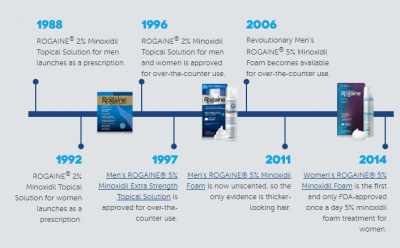This is an old revision of the document.
This FAQ is currently a work-in-progress. Please check back soon for updates. For now, see the current minox FAQ while we improve and update things.
Minoxidil Beard FAQ
Proudly brought to you by the same people that created the original Minox FAQ document, located in a closed Facebook group called The Minox Beard Spot. Group founded and administered by Basik Ali.
What is Minoxidil?
 Minoxidil is a generic medication used for hair regrowth. It was originally developed for treating hypertension (high blood pressure) as an oral medication, and prescribed under the name Loniten1).
Minoxidil is a generic medication used for hair regrowth. It was originally developed for treating hypertension (high blood pressure) as an oral medication, and prescribed under the name Loniten1).
Patients taking the drug orally discovered that — as a side effect — it promoted hair growth on the body. Research has demonstrated, that if applied topically to the scalp as a creme or liquid, it would still grow hair for the majority of people using it. In the United States, over-the-counter versions contain 2% or 5% minoxidil at most, due to FDA regulations.
For more information on minoxidil, read this article on Beard Profile.
Summary: Minoxidil is a hair regrowth solution that also works for hair growth. Note that regrowth and growth are different, as regrowth means that one had or is currently losing their hair (see androgenic alopecia).
What Age Can I Start Using Minoxidil?
There's no set age, but we advise no one younger than 18 to use it. If you're young, see what you can grow before using minox. You may know somebody who is 16 years old with a full beard; this is an exception — there are not many 16 year olds that can grow full beards. Boys finish puberty at approximately 16-20 years old, with many going as far as 22 years old.
Even then, many men cannot grow facial hair at these young ages and realize that their beard genetics kick in around their mid-twenties. Facial hair continues to develop throughout our lives, well into our 30s.
Summary: If you are over 18, feel free to make such a decision on your own after reading this FAQ thoroughly.
Is Minoxidil Intended for Use on the Face?
No. The FDA in the United States of America has approved minoxidil only for use on the scalp. Because of this, the product directions instruct users to apply it only there. More specifically, it is meant only for the vertex of the scalp. Technically, companies selling minoxidil (such as Rogaine) are legally not allowed to advertise the product for any area of the body other than the vertex. This is simply due to the fact that it's the only area that has been tested.
This does not indicate that it does not work elsewhere! We call this false equivalency.
If, however, you apply the product to the face, which has better blood circulation and absorption than the scalp, the likelihood increases that minoxidil will find its way into your bloodstream. We also call this systemic, despite the product being topical. The risk of side effect may increase, including body hair in places other than your face.
Summary: No, because it has never been tested there and approved by the FDA. It has, however, been tested in Thailand2).
How Does Minoxidil Promote Body Hair When You Apply it to Your Face?
See the previous answer.
Additionally, when minoxidil enters your system, it can (and likely will) promote hair growth on the whole body. Various members of TMBS have reported new vellus hair growth on places such as the:
- forehead
- ears
- eyebrows
- upper cheek bones
- hands, legs, feet
- chest, stomach
- back
These new hairs are vellus and have a high probability of falling out once you cease minoxidil applications. In fact, many minoxidil beard users experience cessation of this extra hair even while continuing to apply the solution, several months in.
For more information and suggestions on how to deal with this temporary side effect, see this video from The Beard Solution:
Summary: Body hair is inevitable, but if the hair does not mature into terminal hair, then it will likely go away. This happens whether you apply to your scalp as intended, or to the face. Systemic absorption.
Does Minoxidil Have Any Side Effects?
Of course. It is a drug, after all. Although, most of the common side effects are fairly minor.
The first few applications might make your skin feel itchy or irritated, and possibly a little red. This is common and usually disappears after a few days or couple of weeks as your body adjusts to the minoxidil.
The listed side effects of topical minoxidil can be found here. Take note of oral side effects as well, and disregard those. You will not and do not want to take minoxidil orally during this process.
Summary: Yes, minoxidil can cause some side effects. But so can Tylenol.
How Often Should I Apply Minoxidil?
Twice a day is recommended; once in the morning and once in the evening, roughly twelve hours apart.
Since the human body can only metabolize a certain amount of minoxidil within a 24-hour period, more frequent applications than two per day is unnecessary. Although twice per day is recommended, it is not obligatory.
Some TMBS members report increased sensitivity to minoxidil and can only take one application a day. Other members can only take one application per day due to their work schedules. While results can be expected sooner when applying twice daily, many TMBS members are reporting steady results with only one daily application. Many have completed their minoxidil journey with a single application per day.
Summary: Twice per day, keeping applications 8-12 hours apart. More than that will not make it work any better, and may cause side effects.
